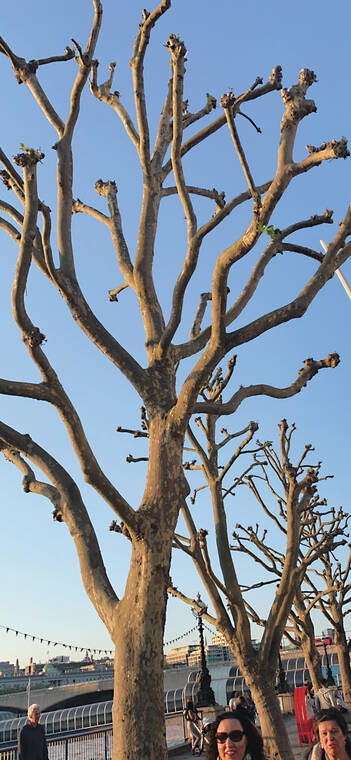Proper pruning can minimize storm damage
In the past, hurricane season officially started June 1 and ended October 31. As our oceans began to warm in the 20th century, the ending date for the season was extended to November 30th. Even though we have had very few storms in our neighborhood over the last couple of years, 2023 is an El Nino year and could prove to be a problem.
What does this mean for us in Hawaii? The old adage — June is too soon, July standby, August a must, September remember, October all over — is no longer accurate. We have been very fortunate to have been free of tropical storms so far this year. This is due to cooler ocean water temperatures over the last couple of La Nina years, but now we may see a warming trend, and that means more storms.
ADVERTISING
What we have learned from storms like Harvey and Irma is that the major damage done from actual winds was to trees like lychee, macadamia mahogany and other broadleaved trees. However, palms like coconut, royal, cabbage palms, Mexican fan palms, Pritchardias and scores of others survived the storm winds. Many will tolerate flooding with little damage as well. If the soil was so soggy that the palms tipped over, they were easy to replant and recover.
Since there are thousands of species, the question is which palms can be used to create your tropical landscape with a minimum of storm damage and care? The Hawaii Island Palm Society is available to help folks answer that question so check out their website.
When it comes to trees other than palms, remember they are important elements of parks, streets and home gardens. Do not forget that they supply oxygen, sequester carbon and in general help to minimize the negative effects of global climate change.
However, they do require proper maintenance to ensure they make it through stormy weather. It is always important to inspect your trees for dead branches that seem to be ready to fall. A gust of wind can snap an arm-sized branch from a tree and send it at missile speed through a picture window.
A low-hanging branch over a roof can wreak havoc. Powerful winds can turn the limb into a tool of destruction. This tool can remove shingles as easily as removing scales from a fish . Removing dead and out of place limbs is a good idea even if there is no storm.
Fan-like fungus growing on the side of a tree trunk indicates rotten spots that need attention. A hole made by poor pruning, damage from earlier storms, or the gouge of an auto bumper can start rotten spots.
Remove decayed trees that are too weak to hold up under the strain of a storm. This action will save you grief later.
Actually, even a hundred-mile-an-hour wind is not as dangerous as it sounds if necessary measures are taken before the wind reaches gale force.
If your home is located in an area that might be flooded, you’ll be given ample notice to evacuate hours before the storm reaches your area. Otherwise, there is no safer place than in a well-built home.
As soon as the storm has passed, it is a good idea to inspect the trees and other plants around the house. Usually all the plants will show signs of wind damage. With a little trimming, propping, resettling of root systems, fertilizing and watering, nearly all plants that were shaken loose from the ground can be salvaged. After hurricane season, it is a good idea to consider root pruning as a way to manage those larger trees.
If in doubt on what to do, you may contact a local certified arborist to assess the situation and correct it.
Many of our tropical trees grow rampant with extensive root systems. That is why we prune to keep them from getting out of hand, but let us prune the right way. Late spring and summer are not the best time for heavy pruning since shade is at a premium during those hot days.
Late fall is a good time as the days are getting shorter and the sun’s rays less intense.
In conclusion, remember that trees are vital to making urban life healthier for us physically, mentally and even spiritually. Forest fires, storms and drought are destroying our forests on a global scale. On the other hand, every time we plant a tree, we help to minimize the effects of global warming.
Enjoy those beautiful trees in your garden by maintaining them correctly. On a grander scale, work with Hawaii County and State governments to plant more trees in parks, and along roads and highways.
We depend on the tourist industry. Visitors to our islands as well as residents appreciate our beautiful landscapes. Without trees, this would just be another barren desert island. Palms, because of their beauty and tenacity, make a great place to be.
Norman Bezona is professor emeritus, University of Hawaii College of Tropical Agriculture and Human Resources.


